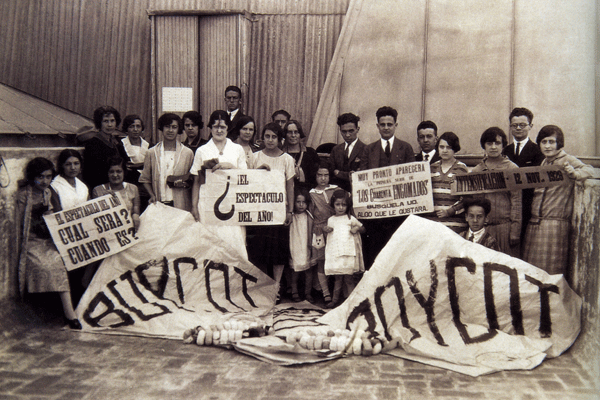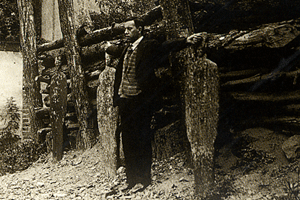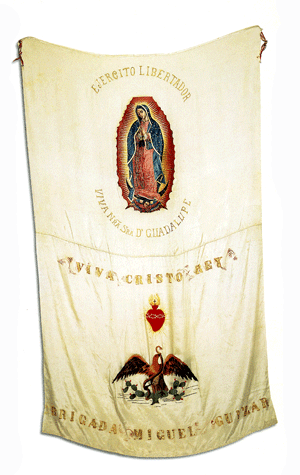
Jesuit Father Miguel Agustín Pro forgave and thanked his executioners moments before his death. “With all my heart, I forgive my enemies,” he declared. “¡Viva Cristo Rey!”

These final words, “Long live Christ the King,” were not so much a defiance of then-Mexican President Plutarco Elias Calles, but a proclamation of his faith. Fr. Pro answered to Jesus Christ, not the Mexican government.
From 1926-1929, the Calles regime enforced anti-clerical laws in Mexico, systematically oppressing religion. Government agents burned churches, harassed nuns and murdered countless Catholics.
The recent film “For Greater Glory” portrays this oppression, and the lay-led war against it, called La Cristiada.
The Cristeros, as those from the countermovement were known, are inspiring Catholics and other people of faith today to stand up against the a controversial U.S. Department of Health and Human Services mandate.
The mandate would require the Catholic Church and other religious employers to provide free health insurance coverage for contraceptives, abortion-inducing drugs and sterilizations.
“When the government is at war with its own citizens, then something has gone wrong, gravely wrong,” Bishop Thomas J. Olmsted declared during a June 8 rally for religious freedom. He began and ended his address by referring to “For Greater Glory.”
“When a government assaults the first freedom of human persons — the freedom of religion, then those citizens must rise up and ask, ‘Who are you to be at war with the people you are called to serve?’” the bishop said.
Baltimore Archbishop William E. Lori, chairman of the U.S. bishops’ Ad Hoc Committee on Religious Freedom, said religious liberty is “front and center” for the Church.
“Religious liberty isn’t given by the government, but by God,” he said during a June 6 press conference with members of the Catholic media. “At the end of the day, the job of a bishop is to be a witness to hope. That could require emulating the witness of St. John Fisher and St. Thomas More.”
Both of those saints gave their lives for religious liberty, as did many Cristeros. More than 250,000 died during La Cristiada.
“If we have to make a choice between violating our faith and getting along, or fulfilling our faith and not getting along, I think the choice is very clear,” the archbishop said. “We might have to struggle mightily, but our weapon is love.”
Faith of ancestors

Josefina Mata, a parishioner at St. Jerome Parish, recalls hearing her great-grandfather tells stories about La Cristiada in Guanajuato, Mexico. Once, while fleeing Mexican federal officials, he felt bullets whipping by his head.
He fell into a river, but his horse pulled him to safety. When he came to, he checked his body for holes. He found a bullet stuck in his cloth scapular.
Her family passed down this story and countless others.
“Their priest would celebrate Mass at night in a cave,” Mata said. Her grandfather left the country despite the 1929 truce between the Church and the Mexican government. Another 50,000 died for being Catholic after the government supposedly agreed to cease the religious suppression.
Estela Padilla, a recent graduate from the Kino Institute, said her grandfather, living in Michoacan, was among the dead.
“They killed my grandfather because he sang at church,” she said. “They went to the house and shot him.”
Historical photographs chronicle the carnage. Mexican government forces hung Cristeros, letting their corpses dangle on telephone lines. The federales would hang signs reading “Death to Christ the King” on dead priests.
Rosie Villegas-Smith, a St. Francis Xavier parishioner, also grew up with stories of La Cristiada. Baptism was done in secret, she said. When it came time for her grandmother to be baptized, only her godparents could go.
Perhaps because they made haste, the godparents forgot the name. Her grandmother was baptized Manuela rather than Margarita.
Thinking of her grandfather, Mata said “For Greater Glory” brings her family’s ancestors to life, especially for her children.
“It makes us proud to see that faith and to know that my great- grandfather stood up in that fight,” she said. “Here, [the Obama administration] is trying to take away our religious rights. We won’t allow it. Our ancestors didn’t permit it, and neither will we.”
These Catholics know about La Cristiada through the stories their families told, not through their school. All traces of La Cristiada were struck from Mexican history books until after the year 2000. Many grew up in Mexico never knowing of the atrocities committed in their own country.
Hidden history
“All of the information was suppressed,” said Gary D. Keller, Regents’ Professor and director of the Hispanic Research Center at Arizona State University. “The whole left wing of the Mexican government was on the case — their lives depended on it.”

It wasn’t until the year 2000 that the Partido Revolucionario Institucional — or simply PRI as it’s known — finally lost an election. They’d held power for 71 years, having been founded by Calles.
“This had nothing to do with land,” Keller said of La Cristiada, swatting away conflicting interpretations of the war. “It had to do with conscience, the right to practice one’s own religion, to educate one’s children in the Church, to celebrate Mass.”
The government reduced the number of priests “to the point of absurdity,” he said. “One state had one priest for the whole state.”
Keller, who studied in Mexico from elementary school through college and earned his doctorate from Columbia in 1971, didn’t find out the full truth about La Cristiada until 2001.
“I was one of the zombies that the Mexican officials created,” he said. “I was outraged by the lies. The Cristero songs were turned into Mexican revolutionary songs when they weren’t.”
More people fled to the United States because of the three-year Cristiada than because of the Mexican revolution that began in 1910. Around 30,000 Catholic women were Cristeros — some served as foot soldiers.
“This was nothing short of a civil war,” he said. “The Cristeros didn’t win and they didn’t lose. They suffered until the 1940s.”
Priests and religious didn’t start wearing cassocks or habits right away, either. The sitting archbishop of Los Angeles welcomed many as refugees.
“The Knights of Columbus made an impact against the attacks of religious freedom in Mexico and we can do that here,” said Fr. Carlos Gomez, pastor of St. Augustine Parish and chaplain of the Arizona Knights of Columbus.
Fr. Christopher Magallanes, who secretly established a seminary in Mexico during the religious oppression, was joined in martyrdom by 21 diocesan priests and three devout laymen. They were all Cristeros and the Universal Church celebrates their feast day May 21.
“They ought to remind not only North American Catholics, but all Catholics all over the world of what was going on,” Fr. Gomez said. “The government tried to destroy the Catholic Church in Mexico.”
The Cristeros can be an inspiration to U.S. Catholics standing up for religious liberty today, he said.
“We are a people of faith and peace, and we have God on our side,” Fr. Gomez said. “It is time to stand up as authentic followers of our Lord.”






